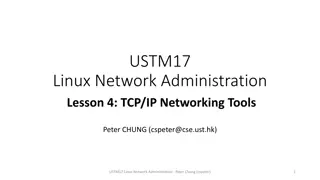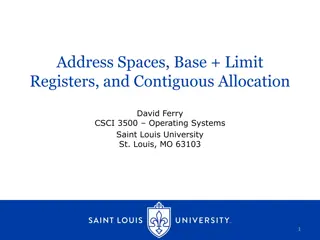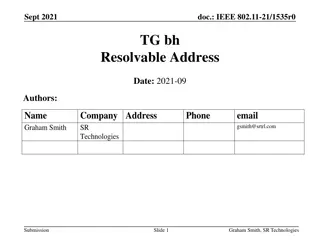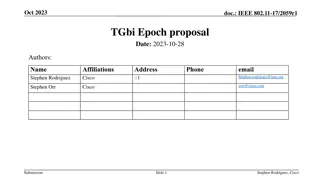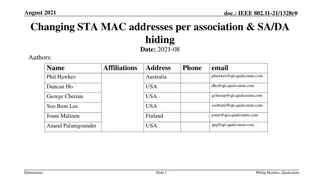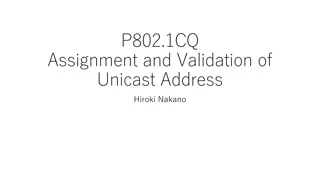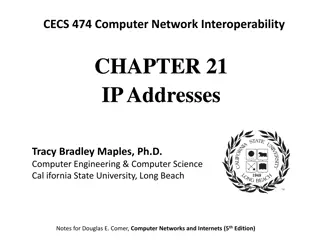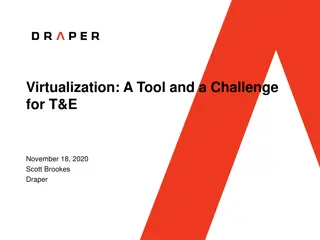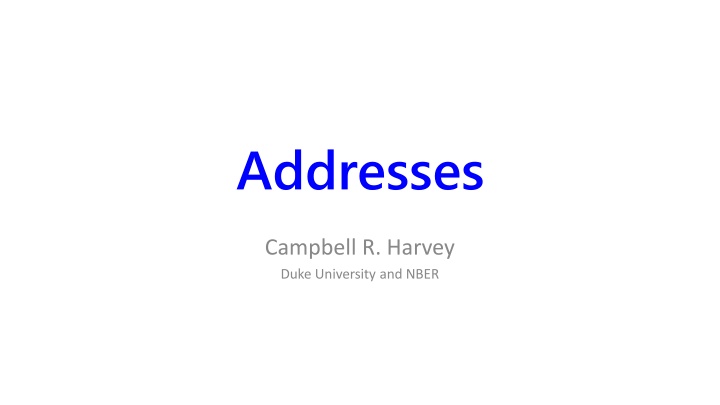
Cryptography and Key Generation in Blockchain Technology
Explore the concepts of Elliptic Curve Digital Signature Algorithm (ECDSA) used in Bitcoin and Ethereum addresses, including the generation of private and public keys, key pairs, and address derivation. Learn about the hashing algorithms like Keccak-256 and the significance of public key formats in securing transactions.
Download Presentation

Please find below an Image/Link to download the presentation.
The content on the website is provided AS IS for your information and personal use only. It may not be sold, licensed, or shared on other websites without obtaining consent from the author. If you encounter any issues during the download, it is possible that the publisher has removed the file from their server.
You are allowed to download the files provided on this website for personal or commercial use, subject to the condition that they are used lawfully. All files are the property of their respective owners.
The content on the website is provided AS IS for your information and personal use only. It may not be sold, licensed, or shared on other websites without obtaining consent from the author.
E N D
Presentation Transcript
Addresses Campbell R. Harvey Duke University and NBER
Addresses Bitcoin and Ethereum uses Elliptic Curve Digital Signature Algorithm* (ECDSA) for signing transactions. I have additional material on EC encryption in a handout called Cryptography 101. Here are the steps. We first generate a private key which is 256 bits (64 hex/32 bytes). We use ECDSA to derive a 512 bit public key (remember, the public key contains information on two coordinates). The private and public keys are known as the key pair . You can sign transactions with the private key Anyone with your public key can verify the signature is valid The Bitcoin and Ethereum addresses are linked to these keys Campbell R. Harvey 2019 3 *Specifically, ECDSA sec256k1. See https://en.bitcoin.it/wiki/Secp256k1
Ethereum Generate a key pair Public key is 512 bits (128 hex characters/64 bytes) Hash with Keccak-256 the public key (64 hex characters/32 bytes) Take last 40 hex characters (20 bytes) as your public address When prefixed with 0x it becomes 42 hex characters http://gavwood.com/paper.pdf Campbell R. Harvey 2019 4
https://www.oreilly.com/library/view/mastering-ethereum/9781491971932/ch04.html5 Ethereum Private key f8f8a2f43c8376ccb0871305060d7b27b0554d2cc72bccf41b2705608452f315 Public key (04 prepended) 046e145ccef1033dea239875dd00dfb4fee6e3348b84985c92f103444683bae07b83b5c38e5e2b0 C8529d7fa3f64d46daa1ece2d9ac14cab9477d042c84c32ccd0 Keccak-256 of public key (remove the 04)* 2a5bc342ed616b5ba5732269001d3f1ef827552ae1114027bd3ecf1f086ba0f9 Last 40 hex (20 bytes) and prepend with 0x 0x001d3f1ef827552ae1114027bd3ecf1f086ba0f9 Campbell R. Harvey 2019 *In the hash of the public key, it is important to let the hashing algo know the format is hex . See https://leventozturk.com/engineering/sha3/
Bitcoin addresses Bitcoin addresses have more steps but the idea is very similar https://en.bitcoin.it/wiki/Technical_background_of_version_1_Bitcoin_addresses Campbell R. Harvey 2019 6
Bitcoin addresses 1. Start with private ECDSA key 18E14A7B6A307F426A94F8114701E7C8E774E7F9A47E2C2035DB29A206321725 2. Take public key generated with it* 0450863AD64A87AE8A2FE83C1AF1A8403CB53F53E486D8511DAD8A04887E5B23522CD470243453A299FA9E77237716103ABC11A1DF38855ED6F2EE187E9C582BA6 3. Perform SHA-256 on public key 600FFE422B4E00731A59557A5CCA46CC183944191006324A447BDB2D98D4B408 Campbell R. Harvey 2019 7 *65 bytes, 1 byte 0x04, 32 bytes corresponding to x-coordinate; 32 bytes for y coordinate
Bitcoin addresses 4. Perform RIPEMD-160 hash on the result of SHA-256 010966776006953D5567439E5E39F86A0D273BEE 5. Add version number byte in front of RIPEMD-160 00010966776006953D5567439E5E39F86A0D273BEE 6. Perform SHA-256 on extended RIPEMD-160 445C7A8007A93D8733188288BB320A8FE2DEBD2AE1B47F0F50BC10BAE845C094 Campbell R. Harvey 2019 8
Bitcoin addresses 7. Perform SHA-256 on the previous SHA-256 D61967F63C7DD183914A4AE452C9F6AD5D462CE3D277798075B107615C1A8A30 8. Take first 4 bytes of 2nd SHA-256 (address checksum) D61967F6 9. Add 4 checksum bytes to extended RIPEMD-160 in stage 5 (25 byte bitcoin address) 00010966776006953D5567439E5E39F86A0D273BEED61967F6 Campbell R. Harvey 2019 9
Bitcoin addresses 10. Convert to base58 (upper and lower case letters, numbers, excluding 0,O,I,l) 16UwLL9Risc3QfPqBUvKofHmBQ7wMtjvM This is the bitcoin address. Campbell R. Harvey 2019 10
Bitcoin addresses Campbell R. Harvey 2019 11
Bitcoin addresses Campbell R. Harvey 2019 12
Addresses Generate a private key and address: https://www.bitaddress.org/ http://bitcoin.stackexchange.com/questions/3041/what-is-a-130-hex- character-public-key https://bitcointalk.org/index.php?topic=78132.0 Campbell R. Harvey 2019 13


